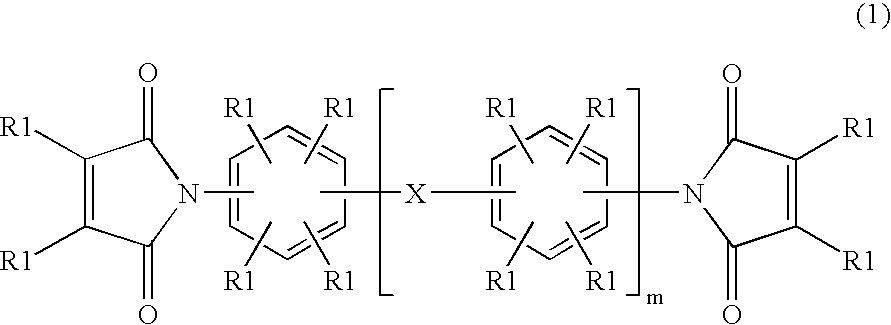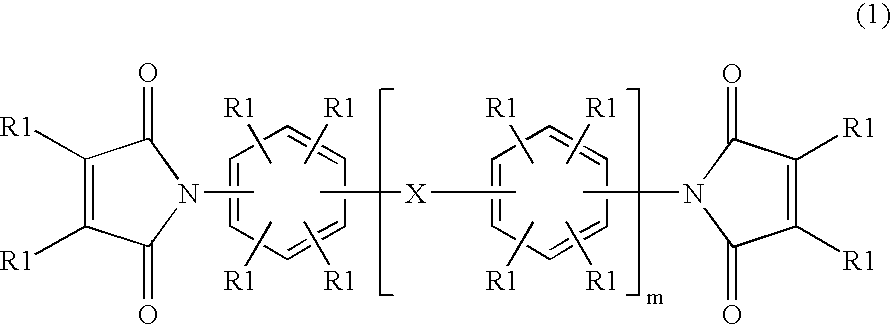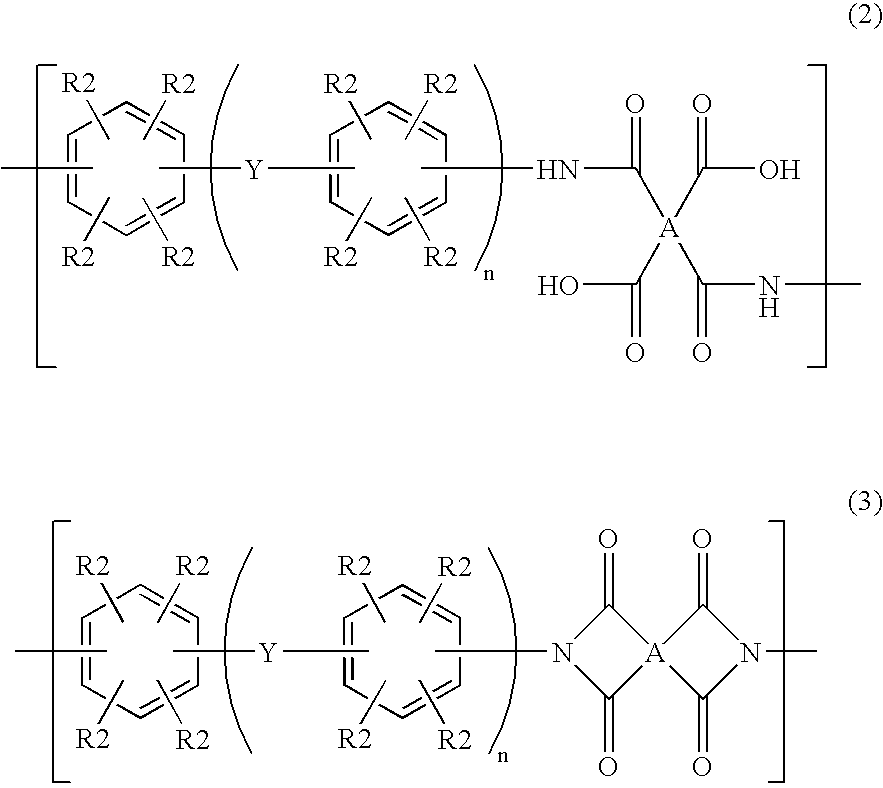Metal laminate
a technology of metal laminates and laminates, applied in the field of metal laminates, can solve the problems of low temperature adhesiveness, heat resistance problems, and many resins that are unsatisfactory from the viewpoint of low-temperature adhesiveness
- Summary
- Abstract
- Description
- Claims
- Application Information
AI Technical Summary
Benefits of technology
Problems solved by technology
Method used
Image
Examples
example 1
[0079] A container equipped with a stirrer and a nitrogen-introducing pipe was charged with 12.00 g of 1,3-bis(3-aminophenoxy)benzene, 15.94 g of 1,3-bis(3-maleimidophenoxy)benzene and 48.70 g of N,N-dimethylacetamide and the mixture was stirred at 50.degree. C. for one hour in a nitrogen atmosphere. Then, the system temperature was cooled to ambient temperature, 11.90 g of 3,3',4,4'-benzophenonetetracarboxylic dianhydride was added stepwise with securing the solution from a sudden temperature rise, and then the system temperature was heated again to 50.degree. C., followed by stirring for 4 hours.
[0080] A part of the polyamic acid solution containing the bismaleimide compound was taken, cast on a glass plate and then heated from 50.degree. C. to 270.degree. C. at a temperature rise rate of 7.degree. C. / min to obtain a film having the thickness of 20 .mu.m. The glass transition temperature (Tg) of the obtained polyimide film was 106.degree. C.
[0081] Also, another part of the polyami...
examples 2 to 4
[0083] The same procedures as in Example 1 as to polymerization, formulation and evaluation were conducted except that the type and amount of the diamine compound or the bismaleimide compound were altered. The types, the amounts and the results are shown together in Table 1. 1,3-bis(3-(3-aminophenoxy)phenoxy)benzene, 1,3-bis(3-(3-(3-aminophenoxy)p-henoxy)phenoxy)benzene and 1,3-bis(3-(3-maleimidophenoxy)phenoxy)benzene were identified using .sup.1H-NMR and FD-mass.
[0084] 1,3-bis(3-(3-aminophenoxy)phenoxy)benzene: .sup.1H-NMR (CD3SOCD3) .delta.: 5.24(s, 4H), 6.12-6.16(ddd, 2H, J=7.83, 2.43, 0.82 Hz), 6.23(t, 2H, J=2.30 Hz), 6.33-6.37(ddd, 2H, J=7.83, 2.43 0.82 Hz), 6.61(t, 2H, J=2.43 Hz), 6.67(t, 1H, J=2.43 Hz), 6.71-6.80(m, 6H), 6.99(t, 2H, J=7.83 Hz), 7.35(t, 2H, J=7.83 Hz), 7.38(t, 1H, J=7.83 Hz) FD-mass 476(M+)
[0085] 1,3-bis(3-(3-(3-aminophenoxy)phenoxy)phenoxy)benzene: .sup.1H-NMR (CD3SOCD3) .delta.: 5.21(s, 4H), 6.11-6.12(ddd, 2H, J=7.83, 2.16, 0.81 Hz), 6.21(t, 8H, J=2.16 Hz),...
example 5
[0087] A container equipped with a stirrer and a nitrogen-introducing pipe was charged with 855 g of N,N-dimethylacetamide as a solvent, to which was then added 69.16 g of 1,3-bis(3-aminophenoxy)benzene. The mixture was stirred at ambient temperature until it was dissolved. Thereafter, 75.84 g of 3,3',4,4'-benzophenonetetracarboxylic dianhydride was added to the solution and the obtained mixture was stirred at 60.degree. C. to obtain a polyamic acid solution, in which the content of polyamic acid was 15% by weight. 48.3 g of 1,3-bis(3-maleimidophenoxy)benzene was added to a part (500 g) of the obtained varnish and the mixture was stirred at ambient temperature for 2 hours.
[0088] Using a commercially available polyimide resin film (product name: KAPTON (trademark) 150EN, manufactured by Toray Du Pont Co., Ltd.), a part of the bismaleimide compound-containing polyamic acid solution obtained in the above method was coated on the film using a roll coater such that the thickness after dr...
PUM
| Property | Measurement | Unit |
|---|---|---|
| Temperature | aaaaa | aaaaa |
| Temperature | aaaaa | aaaaa |
| Temperature | aaaaa | aaaaa |
Abstract
Description
Claims
Application Information
 Login to View More
Login to View More - R&D
- Intellectual Property
- Life Sciences
- Materials
- Tech Scout
- Unparalleled Data Quality
- Higher Quality Content
- 60% Fewer Hallucinations
Browse by: Latest US Patents, China's latest patents, Technical Efficacy Thesaurus, Application Domain, Technology Topic, Popular Technical Reports.
© 2025 PatSnap. All rights reserved.Legal|Privacy policy|Modern Slavery Act Transparency Statement|Sitemap|About US| Contact US: help@patsnap.com



